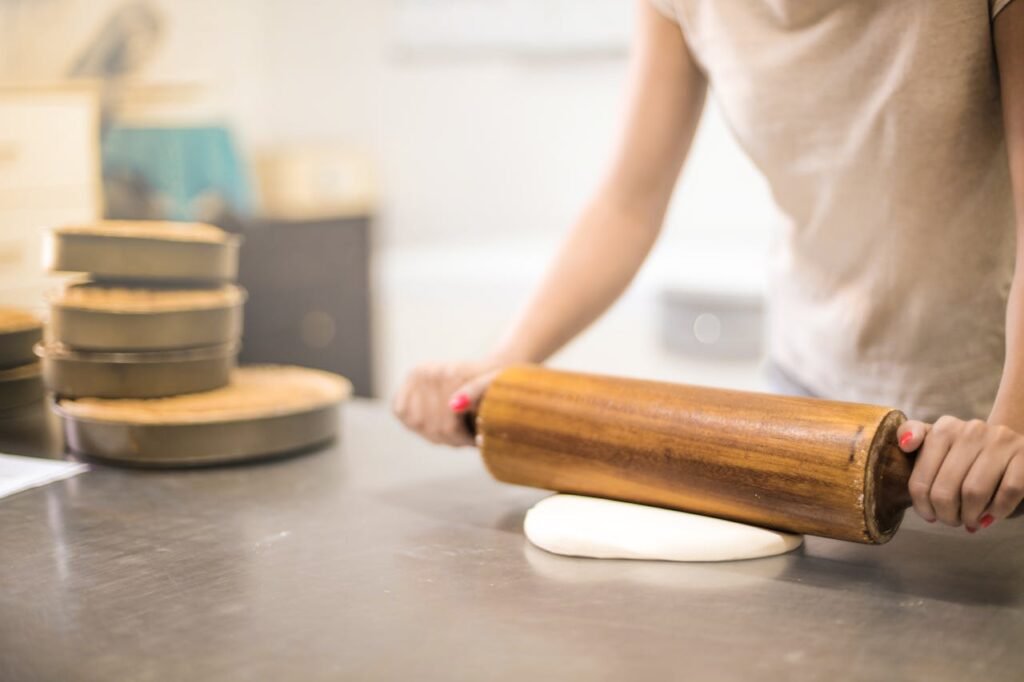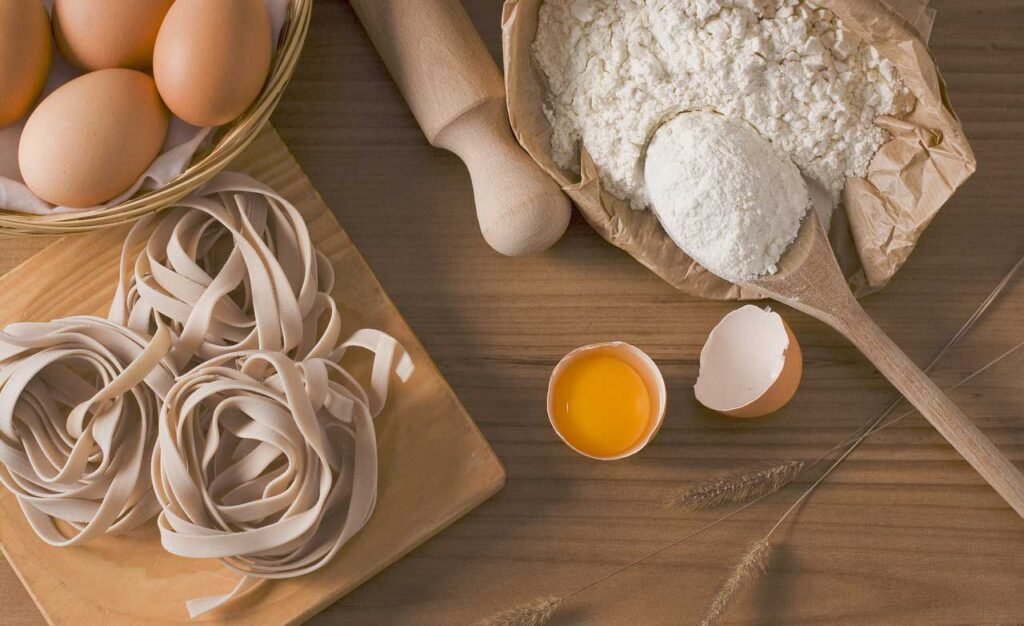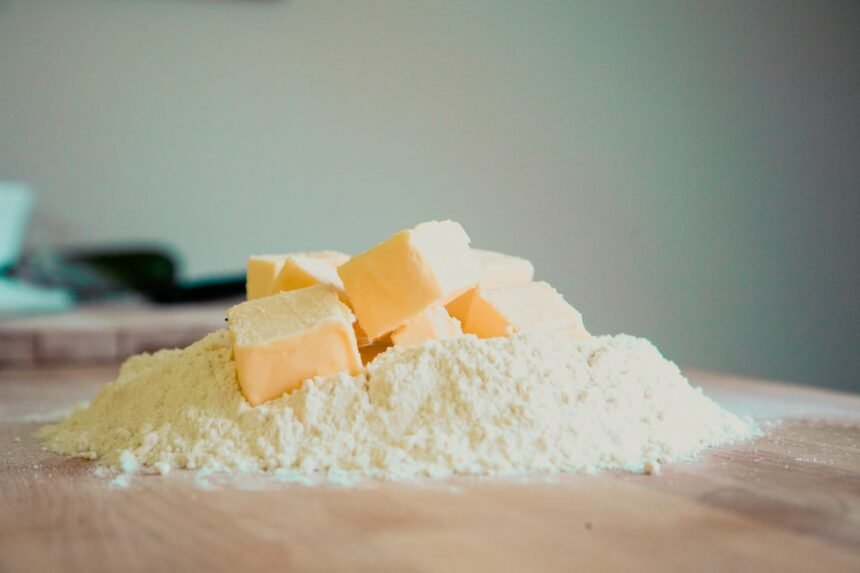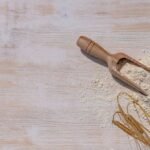Tapioca flour is a versatile and essential ingredient in many kitchens, especially for those following gluten-free diets. This article will explore how to store, use, and incorporate tapioca flour into your cooking, providing you with valuable insights and practical tips to make the most of this unique starch.
What is Tapioca Flour?
Tapioca flour, also known as tapioca starch, is a fine, white powder extracted from the cassava root. This gluten-free flour is prized for its neutral flavour and unique thickening properties. Tapioca flour is a staple in many cuisines worldwide, particularly in South American and Southeast Asian cooking.
The process of making tapioca flour begins with the cassava root, which is peeled, washed, and then ground into a pulp. This pulp is then strained to extract the starchy liquid, which is left to settle. The settled starch is then dried and ground into the fine powder we know as tapioca flour.
Tapioca flour is different from cassava flour, which is made from the whole cassava root. While both are gluten-free, they have different properties and are not interchangeable in recipes. Tapioca flour is pure starch, while cassava flour contains fibre and other nutrients from the whole root.
One of the key benefits of tapioca flour is its versatility. It can be used as a thickener in sauces and soups, as a binding agent in gluten-free baking, and even as a crispy coating for fried foods. Its neutral flavour means it won’t alter the taste of your dishes, making it an excellent choice for both sweet and savoury recipes.
Tapioca flour is also known for its ability to create a chewy texture in baked goods, which is particularly useful in gluten-free baking where achieving the right texture can be challenging. It’s often used in combination with other gluten-free flours to improve the texture and structure of breads, cakes, and cookies.
As we delve deeper into the world of tapioca flour, we’ll explore how to store it properly, use it effectively in your cooking, and incorporate it into a variety of delicious recipes. Whether you’re new to using tapioca flour or looking to expand your culinary repertoire, this guide will provide you with the knowledge and inspiration to make the most of this versatile ingredient.
How to Store Tapioca Flour
Proper storage of tapioca flour is crucial to maintain its quality and extend its shelf life. When stored correctly, tapioca flour can last for several months to a year. Here are some essential tips for storing tapioca flour:
Choosing the Right Container for Tapioca Flour
The first step in storing tapioca flour is selecting an appropriate container. An airtight container is essential to protect the flour from moisture and pests. Glass jars with tight-fitting lids or plastic containers with snap-on lids are excellent choices. Avoid using containers that have absorbed odours from previous contents, as tapioca flour can easily pick up these smells.
If you’ve purchased tapioca flour in a paper bag, it’s best to transfer it to an airtight container as soon as possible. Paper bags are not ideal for long-term storage as they can allow moisture and pests to enter.
Finding the Ideal Storage Location for Tapioca Flour
Once you’ve chosen a suitable container, the next step is to find the right storage location. Tapioca flour should be stored in a cool, dry place away from direct sunlight. A pantry or kitchen cupboard is usually ideal. Avoid storing tapioca flour near heat sources like ovens or radiators, as heat can cause the flour to spoil more quickly.
If you live in a particularly humid climate, you might consider storing your tapioca flour in the refrigerator. However, be sure to bring the flour to room temperature before using it in your recipes, as cold flour can affect the outcome of your baking.
Monitoring the Shelf Life of Tapioca Flour
While tapioca flour has a relatively long shelf life, it’s important to keep track of how long you’ve had it. Most manufacturers recommend using tapioca flour within 9-12 months of opening for best quality. However, properly stored tapioca flour can often last longer than this.
To help you keep track, consider labelling your container with the date you opened it. This will help you use older flour first and ensure you’re always using fresh ingredients in your cooking.
Signs of Spoiled Tapioca Flour
Even with proper storage, tapioca flour can eventually spoil. Here are some signs to look out for:
- Unusual odour: Fresh tapioca flour should have little to no smell. If you notice a musty or off odour, it’s best to discard the flour.
- Discolouration: Tapioca flour should be bright white. If you see any yellowing or other discolouration, this could be a sign of spoilage.
- Clumping: While some clumping is normal due to humidity, large, hard clumps that don’t break apart easily could indicate moisture has gotten into the flour.
- Presence of insects: If you see any signs of insects or larvae in your tapioca flour, discard it immediately.
By following these storage guidelines, you can ensure your tapioca flour remains fresh and ready to use in your cooking and baking. Proper storage not only extends the life of your tapioca flour but also ensures the best results in your recipes. Remember, when in doubt about the freshness of your tapioca flour, it’s always better to err on the side of caution and replace it with a fresh batch.

How to Use Tapioca Flour in Cooking
Tapioca flour is a versatile ingredient that can be used in a variety of ways in cooking and baking. Its unique properties make it an excellent thickener, binder, and texture enhancer. Here’s how you can use tapioca flour effectively in your culinary endeavours:
Tapioca Flour as a Thickener
One of the most common uses of tapioca flour is as a thickener for sauces, soups, and gravies. Unlike cornstarch, tapioca flour creates a glossy, translucent finish, making it ideal for fruit pies and clear sauces. Here’s how to use tapioca flour as a thickener:
- Mix tapioca flour with a cold liquid before adding it to your hot dish. This prevents clumping.
- Use about 1 tablespoon of tapioca flour for every cup of liquid you want to thicken.
- Bring your sauce or soup to a boil after adding the tapioca flour mixture. The liquid needs to reach boiling point for the tapioca to fully activate and thicken.
Remember that tapioca flour thickens quickly and continues to thicken as it cools, so be careful not to add too much.
Tapioca Flour in Gluten-Free Baking
Tapioca flour is a staple in gluten-free baking. It helps to bind ingredients together and provides a chewy texture that’s often missing in gluten-free baked goods. Here are some tips for using tapioca flour in baking:
- Blend with other flours: Tapioca flour works best when combined with other gluten-free flours like rice flour or almond flour. A common ratio is 1 part tapioca flour to 2 parts other flours.
- Add structure to baked goods: Tapioca flour can help create a crispy crust on bread and add structure to cakes and cookies.
- Use as a binding agent: In recipes that call for eggs as a binder, you can often substitute 1 tablespoon of tapioca flour mixed with 3 tablespoons of water for each egg.
Tapioca Flour in Frying
Tapioca flour can create a wonderfully crispy coating for fried foods. Here’s how to use it:
- Dredge your food items in seasoned tapioca flour before frying.
- For an extra crispy coating, mix tapioca flour with rice flour or cornstarch.
- Fry as usual – the tapioca flour will create a light, crispy exterior.
Tapioca Flour in Dairy-Free Recipes
Tapioca flour can be used to create dairy-free cheese alternatives and creamy sauces. When heated with liquid, it develops a stretchy, cheese-like texture. Experiment with nutritional yeast and seasonings to create vegan cheese sauces.
By understanding these various uses of tapioca flour, you can incorporate it into a wide range of recipes, from traditional dishes to innovative culinary creations. Whether you’re thickening a sauce, baking gluten-free treats, or experimenting with dairy-free alternatives, tapioca flour is a valuable tool in your culinary arsenal. In the next section, we’ll explore specific recipes that showcase the versatility of tapioca flour.
Incorporating Tapioca Flour into Your Recipes
Now that we’ve explored the various uses of tapioca flour, let’s dive into some specific recipes and techniques for incorporating this versatile ingredient into your cooking. From traditional dishes to innovative creations, tapioca flour can add unique textures and properties to a wide range of recipes.
Tapioca Flour in Bread Making
Tapioca flour can be a game-changer in gluten-free bread making. It helps create a chewy texture and improves the overall structure of the bread. Here’s a simple recipe for gluten-free sandwich bread using tapioca flour:
Gluten-Free Sandwich Bread with Tapioca Flour
Ingredients:
- 2 cups rice flour
- 1 cup tapioca flour
- 1 tablespoon xanthan gum
- 1 teaspoon salt
- 2 teaspoons active dry yeast
- 2 eggs
- 1/4 cup vegetable oil
- 1 1/4 cups warm water
Instructions:
- Mix all dry ingredients in a bowl.
- In a separate bowl, whisk together eggs, oil, and water.
- Combine wet and dry ingredients, mixing well.
- Pour into a greased loaf pan and let rise for 1 hour.
- Bake at 180°C for 40-45 minutes.
This bread will have a soft interior with a slightly chewy texture, thanks to the tapioca flour.
Tapioca Flour in Desserts
Tapioca flour can add a unique texture to desserts. Here’s a recipe for Brazilian cheese bread (Pão de Queijo), a popular snack that showcases the chewy texture tapioca flour can create:
Brazilian Cheese Bread (Pão de Queijo)
Ingredients:
- 2 cups tapioca flour
- 1 cup milk
- 1/2 cup vegetable oil
- 2 eggs
- 1 cup grated cheese (Parmesan or cheddar)
- 1 teaspoon salt
Instructions:
- Preheat oven to 200°C.
- In a saucepan, bring milk and oil to a boil.
- Remove from heat and stir in tapioca flour until well combined.
- Let cool slightly, then mix in eggs, cheese, and salt.
- Form into small balls and place on a baking sheet.
- Bake for 20-25 minutes until golden brown.
These cheese breads have a crispy exterior and a chewy, cheese-filled interior – a perfect showcase of tapioca flour’s unique properties.
Tapioca Flour in Sauces and Gravies
Tapioca flour is an excellent thickener for sauces and gravies. Here’s a simple recipe for a gluten-free gravy:
Gluten-Free Gravy with Tapioca Flour
Ingredients:
- 2 cups meat drippings or broth
- 2 tablespoons tapioca flour
- Salt and pepper to taste
Instructions:
- In a small bowl, whisk tapioca flour with a little cold water to create a slurry.
- Bring meat drippings or broth to a simmer in a saucepan.
- Slowly whisk in the tapioca flour slurry.
- Continue to simmer, stirring constantly, until the gravy thickens.
- Season with salt and pepper to taste.
This gravy will have a glossy appearance and smooth texture, perfect for pouring over your favourite roast dinner.
By incorporating tapioca flour into these and other recipes, you can explore its unique properties and discover new ways to enhance your cooking. Whether you’re making bread, desserts, or savoury dishes, tapioca flour can add interesting textures and improve the overall quality of your gluten-free cooking. In the next section, we’ll look at some tips and tricks for working with tapioca flour to help you get the best results in your culinary experiments.
Tips and Tricks for Working with Tapioca Flour
Working with tapioca flour can be a bit different from using traditional wheat flour. Here are some tips and tricks to help you get the best results when cooking and baking with tapioca flour:
Understanding Tapioca Flour’s Properties
- Absorption: Tapioca flour absorbs liquids differently than wheat flour. It tends to absorb more liquid, so you may need to adjust the liquid content in your recipes.
- Texture: Tapioca flour can create a chewy, stretchy texture in baked goods. This can be desirable in some recipes (like Brazilian cheese bread) but may not be suitable for all baked goods.
- Binding: While tapioca flour can act as a binder, it’s not as strong as eggs or xanthan gum. In gluten-free baking, you may need to combine it with other binders for the best results.
- Flavour: Tapioca flour has a neutral flavour, which makes it versatile for both sweet and savoury recipes.
Measuring Tapioca Flour
Accurate measurement is crucial when working with tapioca flour:
- Use the spoon and level method: Spoon the flour into your measuring cup and level it off with a straight edge. Don’t scoop directly with the measuring cup, as this can compress the flour and lead to using too much.
- Consider weighing: For the most accurate measurements, use a kitchen scale. One cup of tapioca flour typically weighs about 120 grams.
Combining Tapioca Flour with Other Ingredients
- Mix with other flours: In gluten-free baking, tapioca flour works best when combined with other gluten-free flours. A common ratio is 1 part tapioca flour to 2 parts other flours (like rice flour or almond flour).
- Add gradually: When using tapioca flour as a thickener, add it gradually and whisk well to prevent clumping.
- Blend well: When using tapioca flour in baked goods, make sure it’s well blended with other dry ingredients before adding wet ingredients.
Adjusting Recipes
When substituting tapioca flour for wheat flour or other starches:
- Start small: Begin by replacing about 25% of the flour in a recipe with tapioca flour and adjust from there.
- Expect different textures: Tapioca flour can make baked goods more chewy and dense. You may need to adjust other ingredients to achieve the desired texture.
- Be prepared to experiment: Every recipe is different, so be prepared to make a few test batches to get the right balance when incorporating tapioca flour.
Storing and Handling Tapioca Flour
- Keep it dry: Tapioca flour is very sensitive to moisture. Always use a dry spoon when scooping it out of its container.
- Store properly: Keep tapioca flour in an airtight container in a cool, dry place. If you live in a humid climate, consider storing it in the refrigerator.
- Check for freshness: Tapioca flour can go rancid. If it smells off or has any discolouration, it’s best to discard it.
By keeping these tips and tricks in mind, you’ll be better equipped to work with tapioca flour in your cooking and baking. Remember, working with new ingredients often requires some experimentation, so don’t be discouraged if your first attempts aren’t perfect. With practice, you’ll soon be creating delicious gluten-free dishes with tapioca flour.

Tapioca Flour Substitutes
While tapioca flour is a versatile and useful ingredient, there may be times when you need a substitute. Whether you’ve run out of tapioca flour or are looking for alternatives due to dietary restrictions or personal preference, here are some options to consider:
Certainly! I’ll continue the article from where we left off:
Arrowroot Powder
Arrowroot powder is perhaps the closest substitute for tapioca flour. Like tapioca, it’s a starch extracted from a root vegetable. It has similar thickening properties and creates a glossy finish in sauces. Use arrowroot powder in a 1:1 ratio when substituting for tapioca flour.
Pros:
- Similar thickening power
- Creates a glossy finish
- Neutral flavour
Cons:
- Can be more expensive than tapioca flour
- Not ideal for dairy-based sauces as it can create a slimy texture
Cornstarch
Cornstarch is a common thickener that can be used in place of tapioca flour in many recipes. It’s readily available and works well in sauces, soups, and pie fillings. Use 1 tablespoon of cornstarch for every 1 1/2 tablespoons of tapioca flour.
Pros:
- Widely available
- Inexpensive
- Effective thickener
Cons:
- Creates a more opaque finish compared to tapioca flour
- Can break down if overheated or frozen
Potato Starch
Potato starch is another gluten-free option that can replace tapioca flour in many recipes. It’s particularly good for thickening sauces and creating crispy coatings. Use potato starch in a 1:1 ratio when substituting for tapioca flour.
Pros:
- Good thickening power
- Creates crispy textures in fried foods
- Neutral flavour
Cons:
- Can break down at high temperatures
- Not ideal for long-cooking dishes
Rice Flour
Rice flour can be a good substitute in some baking recipes, particularly when combined with other gluten-free flours. It doesn’t have the same thickening power as tapioca flour but can help improve texture in gluten-free baked goods.
Pros:
- Mild flavour
- Works well in gluten-free flour blends
- Good for crispy coatings
Cons:
- Not as effective as a thickener
- Can make baked goods denser
Cassava Flour
While not identical to tapioca flour, cassava flour is made from the whole cassava root and can be used as a substitute in some recipes. It has more fibre than tapioca flour and can be used in a 1:1 ratio in many recipes calling for all-purpose flour.
Pros:
- Similar flavour profile to tapioca flour
- Can be used as a 1:1 substitute for wheat flour in many recipes
- High in fibre
Cons:
- Not as effective as a thickener
- Can make baked goods denser
When substituting tapioca flour, it’s important to consider the specific role it plays in your recipe. If it’s being used primarily as a thickener, arrowroot powder or cornstarch might be your best bet. For baking, a combination of alternative flours might be necessary to achieve the desired texture and structure.
Remember that each substitute will behave slightly differently, so you may need to experiment to get the best results. Don’t be afraid to adjust liquid levels or cooking times as needed when using these substitutes.
Nutritional Profile of Tapioca Flour
Understanding the nutritional profile of tapioca flour is important for incorporating it effectively into your diet. Here’s a breakdown of what tapioca flour offers nutritionally:
Macronutrients in Tapioca Flour
Tapioca flour is primarily composed of carbohydrates, with very little protein or fat. Here’s the approximate nutritional content per 100 grams of tapioca flour:
| Nutrient | Amount |
|---|---|
| Calories | 358 |
| Carbohydrates | 88.7g |
| Protein | 0.2g |
| Fat | 0.1g |
| Fibre | 0.9g |
As you can see, tapioca flour is very high in carbohydrates and low in other macronutrients. This makes it an excellent energy source, but it’s not a significant source of protein or essential fatty acids.
Micronutrients in Tapioca Flour
Tapioca flour is not particularly rich in vitamins or minerals. However, it does contain small amounts of:
- Calcium
- Iron
- Potassium
- Vitamin C
- B-vitamins (in trace amounts)
It’s worth noting that the micronutrient content can vary depending on the processing methods used.
Glycemic Index of Tapioca Flour
Tapioca flour has a high glycemic index (GI) of about 85. This means it can cause a rapid increase in blood sugar levels when consumed. For this reason, people with diabetes or those monitoring their blood sugar should use tapioca flour in moderation.
Benefits of Tapioca Flour
Despite its limited nutritional profile, tapioca flour offers several benefits:
- Gluten-free: It’s safe for people with celiac disease or gluten sensitivity.
- Easy to digest: Its simple starch structure makes it easy on the digestive system.
- Allergen-friendly: It’s free from common allergens like nuts, soy, and dairy.
- Versatile: Its neutral flavour and unique properties make it useful in a variety of recipes.
Considerations When Using Tapioca Flour
While tapioca flour can be a valuable ingredient, especially in gluten-free cooking, it’s important to use it as part of a balanced diet. Here are some considerations:
- Combine with nutrient-dense ingredients: Since tapioca flour is low in nutrients, pair it with foods rich in protein, vitamins, and minerals.
- Use in moderation: Due to its high carbohydrate content and GI, it’s best used in moderation, especially for those watching their blood sugar or calorie intake.
- Consider fortified options: Some manufacturers offer tapioca flour fortified with vitamins and minerals, which can be a good option for boosting nutrient intake.
Understanding the nutritional profile of tapioca flour can help you use it more effectively in your cooking while maintaining a balanced diet. In the next section, we’ll address some frequently asked questions about tapioca flour to further enhance your understanding of this versatile ingredient.

Frequently Asked Questions About Tapioca Flour
To round off our comprehensive guide to tapioca flour, let’s address some common questions that often arise when working with this ingredient:
Q1: Is tapioca flour the same as cassava flour?
A: No, tapioca flour and cassava flour are not the same, although they both come from the cassava root. Tapioca flour is made from the starch extracted from the cassava root, while cassava flour is made from the whole root that has been peeled, dried, and ground. They have different properties and are not interchangeable in recipes.
Q2: Can I use tapioca flour instead of cornstarch?
A: Yes, you can often substitute tapioca flour for cornstarch as a thickener. Use about 2 tablespoons of tapioca flour for every 1 tablespoon of cornstarch. Remember that tapioca flour creates a more transparent, glossy finish compared to cornstarch.
Q3: Is tapioca flour keto-friendly?
A: Tapioca flour is not typically considered keto-friendly due to its high carbohydrate content. Those following a strict ketogenic diet should avoid or severely limit their intake of tapioca flour.
Q4: How long does tapioca flour last?
A: When stored properly in an airtight container in a cool, dry place, tapioca flour can last up to 1-2 years. However, for best quality, it’s recommended to use it within 9-12 months of opening.
Q5: Can tapioca flour be used in place of all-purpose flour?
A: Tapioca flour cannot be used as a 1:1 substitute for all-purpose flour in most recipes. It lacks the protein content of wheat flour and behaves differently in baking. However, it can be used as part of a gluten-free flour blend to replace all-purpose flour.
Q6: Is tapioca flour good for weight loss?
A: Tapioca flour is not particularly beneficial for weight loss as it’s high in calories and carbohydrates with little fibre or protein. However, when used in moderation as part of a balanced diet, it can be included in a weight management plan, especially for those requiring gluten-free options.
Q7: Can I make my own tapioca flour at home?
A: While it’s possible to make tapioca flour at home, it’s a complex process that requires specific equipment. It involves grating cassava root, extracting the starch, drying it, and then grinding it into a fine powder. For most home cooks, it’s more practical to purchase ready-made tapioca flour.
Q8: Does tapioca flour contain cyanide?
A: The cassava plant, from which tapioca flour is derived, does contain compounds that can produce cyanide. However, the processing of tapioca flour removes these compounds, making it safe for consumption.
Q9: Can I use tapioca flour in bread making?
A: Yes, tapioca flour is often used in gluten-free bread recipes. It helps create a chewy texture and can improve the structure of gluten-free breads. However, it’s typically used in combination with other gluten-free flours rather than on its own.
Q10: Is tapioca flour inflammatory?
A: Tapioca flour is not typically considered an inflammatory food. In fact, it’s often recommended for people following anti-inflammatory diets due to its gluten-free nature. However, its high glycemic index might be a concern for some individuals.
By addressing these frequently asked questions, we hope to have cleared up any lingering doubts about tapioca flour. Remember, while tapioca flour is a versatile and useful ingredient, especially in gluten-free cooking, it’s always best to use it as part of a varied and balanced diet.
In conclusion, tapioca flour is a unique and versatile ingredient that can add interesting textures and properties to your cooking and baking. Whether you’re thickening a sauce, creating gluten-free baked goods, or experimenting with new recipes, tapioca flour can be a valuable addition to your pantry. By understanding how to store it properly, use it effectively, and incorporate it into various dishes, you can make the most of this fascinating flour. So don’t be afraid to experiment and discover the many ways tapioca flour can enhance your culinary creations!





